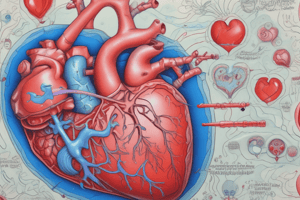Podcast
Questions and Answers
What is the most common congenital heart defect?
What is the most common congenital heart defect?
- Patent ductus arteriosus (PDA)
- Atrial septal defect (ASD)
- Ventricular septal defect (VSD) (correct)
- Tetralogy of Fallot
What condition is generally irreversible and signifies a shift from left to right shunt in congenital heart disease?
What condition is generally irreversible and signifies a shift from left to right shunt in congenital heart disease?
- Endocarditis
- Cyanosis
- Eisenmenger's syndrome (correct)
- Polycythemia
In congenital heart disease, what do children do to increase systemic vascular resistance and decrease right-to-left shunts?
In congenital heart disease, what do children do to increase systemic vascular resistance and decrease right-to-left shunts?
- Lie down
- Jump
- Squat (correct)
- Stand up
Which congenital heart disease presents with cyanosis and can lead to complications such as polycythemia and strokes?
Which congenital heart disease presents with cyanosis and can lead to complications such as polycythemia and strokes?
Which connection shunts blood away from the liver in utero?
Which connection shunts blood away from the liver in utero?
Which congenital heart defect usually causes symptoms after 4–6 weeks of life?
Which congenital heart defect usually causes symptoms after 4–6 weeks of life?
What is the most common site of native valve infections?
What is the most common site of native valve infections?
Which organism is responsible for 50% of endocarditis cases?
Which organism is responsible for 50% of endocarditis cases?
What is the most common benign tumor of the heart?
What is the most common benign tumor of the heart?
What is the most common malignant tumor of the heart?
What is the most common malignant tumor of the heart?
What is the most common metastatic tumor to the heart?
What is the most common metastatic tumor to the heart?
What is indicated when there is mediastinal bleeding of more than 500 cc for the first hour or more than 250 cc/h for 4 hours?
What is indicated when there is mediastinal bleeding of more than 500 cc for the first hour or more than 250 cc/h for 4 hours?
What characterizes post-pericardiotomy syndrome?
What characterizes post-pericardiotomy syndrome?
What is recommended for the treatment of post-pericardiotomy syndrome?
What is recommended for the treatment of post-pericardiotomy syndrome?
What should be done in case of significant learning outcomes?
What should be done in case of significant learning outcomes?
Which of the following is essential for successful therapy in endocarditis?
Which of the following is essential for successful therapy in endocarditis?
Which congenital heart defect results in cyanosis?
Which congenital heart defect results in cyanosis?
What is the most common cause of death in the United States?
What is the most common cause of death in the United States?
Which valve disease is commonly caused by leaflet prolapse?
Which valve disease is commonly caused by leaflet prolapse?
What is the usual timing of repair for atrial septal defects?
What is the usual timing of repair for atrial septal defects?
What is the primary morphologic abnormality in Tetralogy of Fallot?
What is the primary morphologic abnormality in Tetralogy of Fallot?
What is the best conduit for coronary artery bypass grafting (CABG)?
What is the best conduit for coronary artery bypass grafting (CABG)?
What are the complications of myocardial infarction?
What are the complications of myocardial infarction?
Which valve disease is rare and most commonly caused by rheumatic fever?
Which valve disease is rare and most commonly caused by rheumatic fever?
What causes constriction of the heart in constrictive pericarditis?
What causes constriction of the heart in constrictive pericarditis?
What is the primary risk factor for high mortality in coronary artery bypass grafting (CABG)?
What is the primary risk factor for high mortality in coronary artery bypass grafting (CABG)?
Which congenital heart defect results in bounding peripheral pulses and widened pulse pressure?
Which congenital heart defect results in bounding peripheral pulses and widened pulse pressure?




